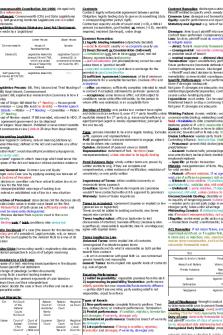Exam 1 cheat sheet - Lecture notes 1-7 PDF

| Title | Exam 1 cheat sheet - Lecture notes 1-7 |
|---|---|
| Author | Emily Elmer |
| Course | Introduction to Accountng |
| Institution | University of Missouri |
| Pages | 1 |
| File Size | 68.3 KB |
| File Type | |
| Total Downloads | 57 |
| Total Views | 116 |
Summary
Exam 1 cheat sheet...
Description
Accounting is the Framework for Understanding Business Cost of goods sold is usually company’s largest expense Types of companies: Calculating Cost of Goods Sold (COGS) Service - Perform services - Hair salons, Cleaning places Beg Inv. + Cost of Inv. Purchased – End Inv. = COGS Manufacturing - Make and sell products - Apple, Dell/Microsoft, Dodge Merchandising - Buy goods and resell - Wholesalers - plumbing or electrical supply stores. Retailers - Target, Walgreens Business organizations: Temporary Accounts - always get closed to $0 in end: Sole proprietor Expense and revenue accounts Partnership Pre-closing = before closing temp accounts Corporation Post-closing = after closing temp accounts Managerial Accounting Info Only used for managers - no rules as to how laid out Balance sheet is a point-in-time financial report Financial Accounting Info Always stated As of….. Used for public interest - set rules called GAAP (generally accepted accounting principles) made by SEC and FASB Includes Balance Sheet, Income Statement, Statement of Retained Earnings, Statement of Cash Flows Accounting basics Assets Stuff - Economic resources the company owns that provides benefits for company Liabilities Claims to stuff of someone who is NOT an owner - obligation to pay back Owners Equity Claims to stuff of someone who IS an owner plus accumulated net earnings Accounting equation Assets = Liabilities + Owners Equity (ALE) Assets = Liabilities + Owner’s Equity + Net Income Assets = Liabilities + Owner’s Equity + Revenue - Expenses Debit Increases Dividends, Expenses, and Assets Decreases Liabilities, Equity (Owners’ Equity), and Revenue Credit Increases Liabilities, Equity (Owners’ Equity), and Revenue Decreases Dividends, Expenses, and Assets Current assets Cash, marketable securities, receivables, inventory, prepaid items Long term investments Notes receivable, gov. Bonds, corporate bonds, capital stock of other companies, other securities Property and equipment - fixed or operating assets Land, building, equipment, furniture Current liabilities Accounts and salaries payable, unearned revenue, short-term notes and interest payable Noncurrent liabilities Notes payable, mortgage payable, bonds payable DISCOUNTS Quantity discount Reduction in sales price of a good or service because of the number of items purchased or because of a sales promotion. Buy one get one ½ off Sales or cash discount Percentage reduction of the invoice price if the customer pays the invoice within a specific period 2/20, n30 2/20 = The customer is allowed a 2% discount if they pay within 20 days of the invoice date n30 = The total invoice price is due in 30 days of the invoice date Sales returns Occurs when a customer returns previously purchased merchandise. Effect is to cancel the sale and the related cost of goods sold Sales allowance Occurs when a customer agrees to keep the merchandise and the company refunds a portion of the original sales price...
Similar Free PDFs

Exam 1 Cheat Sheet
- 17 Pages

Exam 1 Cheat Sheet
- 2 Pages

Exam 1 Cheat Sheet
- 2 Pages

Exam 1 cheat sheet
- 2 Pages

Exam 1 Cheat sheet
- 2 Pages

Exam 1 Cheat Sheet
- 2 Pages

Cheat sheet exam 1
- 2 Pages

Sheet cheat exam 1
- 3 Pages

Exam 1 Cheat Sheet
- 2 Pages

Cheat sheet - Lecture notes 1-15
- 2 Pages
Popular Institutions
- Tinajero National High School - Annex
- Politeknik Caltex Riau
- Yokohama City University
- SGT University
- University of Al-Qadisiyah
- Divine Word College of Vigan
- Techniek College Rotterdam
- Universidade de Santiago
- Universiti Teknologi MARA Cawangan Johor Kampus Pasir Gudang
- Poltekkes Kemenkes Yogyakarta
- Baguio City National High School
- Colegio san marcos
- preparatoria uno
- Centro de Bachillerato Tecnológico Industrial y de Servicios No. 107
- Dalian Maritime University
- Quang Trung Secondary School
- Colegio Tecnológico en Informática
- Corporación Regional de Educación Superior
- Grupo CEDVA
- Dar Al Uloom University
- Centro de Estudios Preuniversitarios de la Universidad Nacional de Ingeniería
- 上智大学
- Aakash International School, Nuna Majara
- San Felipe Neri Catholic School
- Kang Chiao International School - New Taipei City
- Misamis Occidental National High School
- Institución Educativa Escuela Normal Juan Ladrilleros
- Kolehiyo ng Pantukan
- Batanes State College
- Instituto Continental
- Sekolah Menengah Kejuruan Kesehatan Kaltara (Tarakan)
- Colegio de La Inmaculada Concepcion - Cebu





